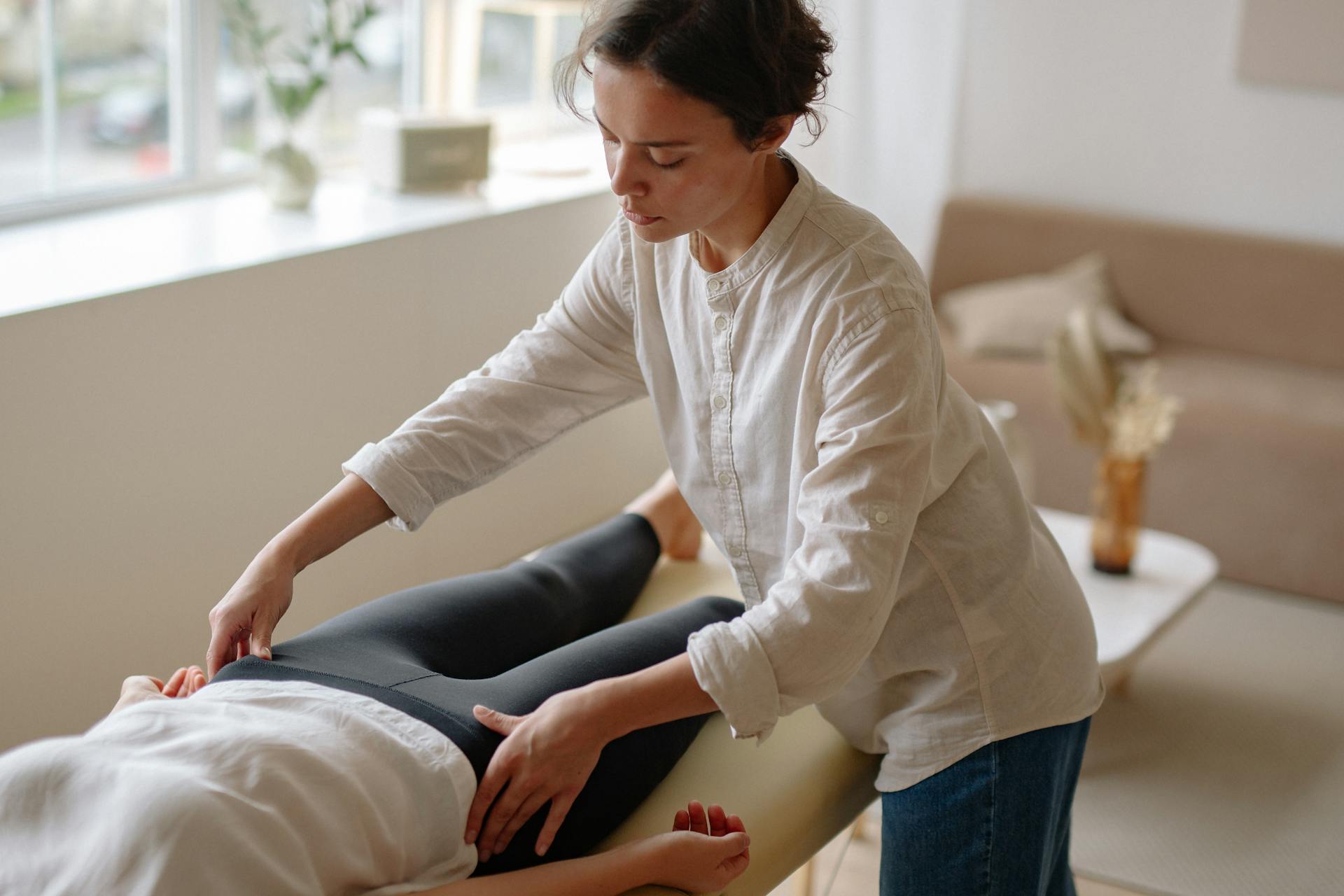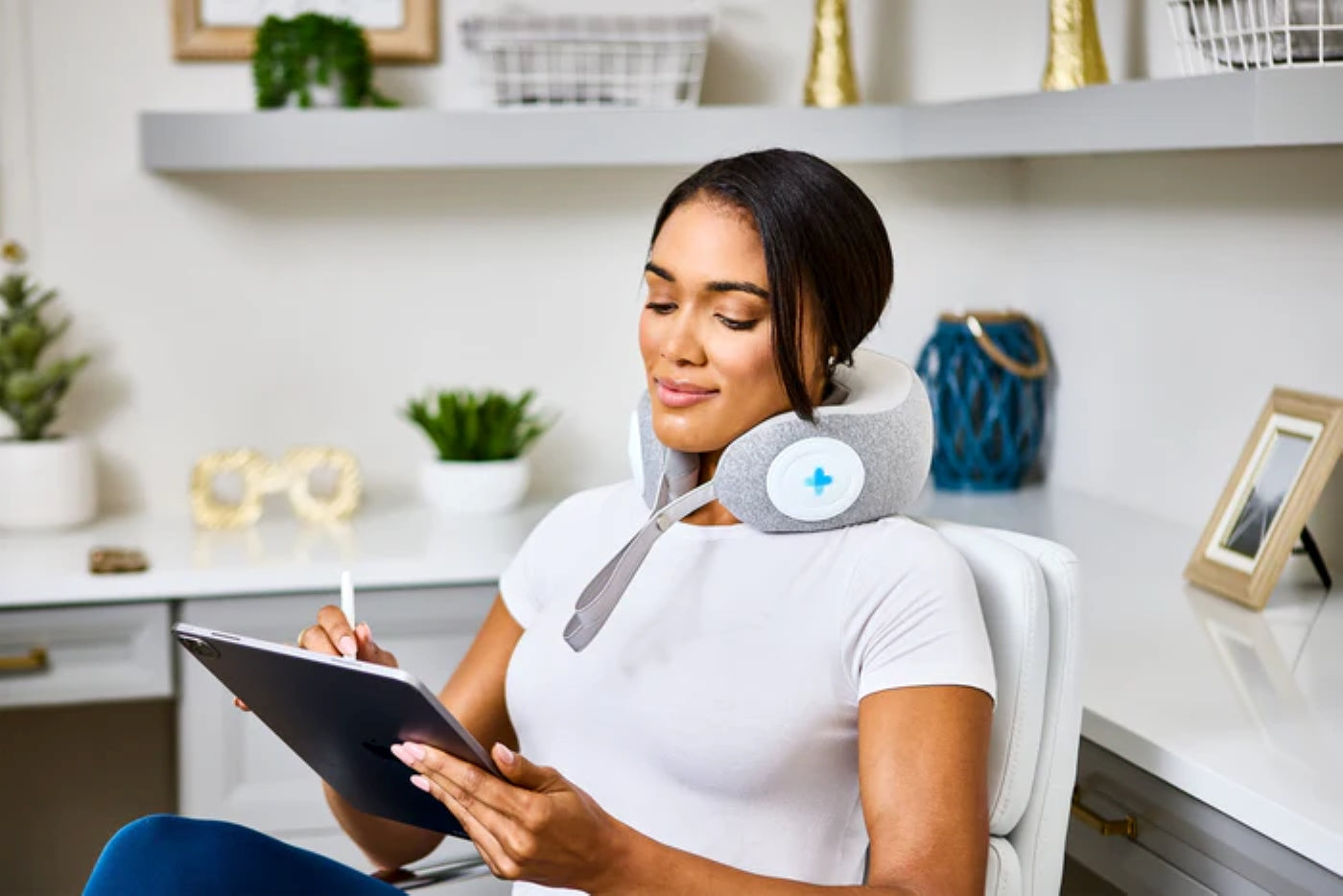Desde una mala postura hasta dormir en una posición incómoda o una postura incorrecta durante tu último entrenamiento, hay infinitas razones por las que puedes acabar con dolor en la nuca. Los músculos de esta zona trabajan constantemente para sostener la cabeza —que, en promedio, pesa entre 2 y 4.5 kg— y un movimiento en falso podría dejarte dolorido durante días.
Afortunadamente, si buscas aliviar el dolor rápidamente, promover una postura saludable o simplemente quieres darle a tu cuello un poco más de cariño, el automasaje puede ayudar.
Esto es lo que debe saber sobre el masaje de la nuca, incluidos los beneficios, las técnicas y las herramientas para que el masaje en casa sea un poco más fácil.
¿Qué sucede ahí atrás? Un vistazo a los músculos de la nuca.
El músculo más grande y superficial (o más externo) de la parte posterior del cuello es el músculo trapecio , un músculo ancho y en forma de abanico que comienza en la base del cráneo, se extiende hacia los hombros y baja hasta la mitad de la espalda.
Justo debajo del trapecio, se encuentran dos músculos cervicales más profundos: el esplenio de la cabeza y el esplenio cervical. Estos dos músculos son responsables de gran parte del trabajo pesado al sostener, rotar e inclinar la cabeza, pero no lo hacen solos. Otros músculos de la nuca que contribuyen al movimiento y la estabilidad de la cabeza incluyen:
- Músculos suboccipitales , un conjunto de pequeños músculos cerca de la base del cráneo.
- Músculos transversoespinales cervicales , un grupo de músculos del cuello más profundos y cercanos a la columna vertebral.
- Músculos elevadores de la escápula , que recorren la parte posterior del cuello.
Causas del dolor en la nuca
Si hoy se despertó con dolor o tensión en la nuca, estos son algunos factores que podrían influir:
Uso excesivo y tensión
Aunque no pensamos mucho en ello, los músculos del cuello soportan mucha tensión a diario, a menudo debido a ejercicios de levantamiento de objetos pesados, movimientos repetitivos o simplemente una mala postura.
Un ejemplo específico (y muy común) de esto es la postura de cabeza adelantada . Por cada centímetro que la cabeza se inclina hacia adelante, se añaden varios kilos de presión extra en la nuca, presión que los músculos deben combatir constantemente para mantener la cabeza erguida. Con el tiempo, este tipo de tensión constante puede causar inflamación que puede contribuir (o causar directamente) al dolor muscular del cuello.
Condiciones de salud
Con menos frecuencia, ciertas lesiones y afecciones de salud también pueden contribuir al dolor de nuca. Entre ellas se incluyen:
- Osteoartritis en la columna cervical
- Lesiones por accidentes o deportes, como un latigazo cervical o una distensión muscular.
- Problemas de disco cervical, como una hernia de disco
- Un nervio pinzado debido a una lesión, una afección de la columna o un esfuerzo repetitivo.
Otros factores contribuyentes
Si bien el cansancio muscular es la causa más común del dolor de cuello, no es el único factor a considerar. Incluso cambios cotidianos sencillos, como las bajas temperaturas o la deshidratación, pueden provocar calambres, tensión y espasmos musculares con mayor facilidad.
Además, tu ergonomía diaria (o la configuración de tu espacio de trabajo) también puede ser fundamental. Ya sea que trabajes en un escritorio o pases horas al día en tu vehículo, una configuración que no sea cómoda para el cuello puede aumentar la carga sobre tus músculos, haciéndolos más propensos al dolor y la fatiga al final del día.
Esto puede incluso afectar la forma en que duermes; las almohadas apiladas demasiado altas (o demasiado bajas) pueden provocar que tu cuello se doble de forma antinatural, limitando la circulación y provocando que se acumule tensión durante la noche.
Los beneficios del masaje en la nuca
Para el cuidado de la nuca, el masaje puede aportar beneficios muy reparadores, especialmente si sufres de tensión postural o de mala noche de sueño. Aquí tienes cuatro de los principales efectos positivos que puedes esperar:
Se enfoca en la tensión muscular
Las investigaciones demuestran que, en personas con dolor de cuello crónico, la parte superior del trapecio suele estar especialmente tensa. Afortunadamente, un masaje suave puede ayudar a calentar y movilizar el tejido; un pequeño estudio sugiere que puede ser especialmente útil para relajar la tensión en los músculos trapecios.
Además, una técnica llamada liberación miofascial puede ser excelente para aliviar puntos gatillo y nudos en la parte superior de la espalda y el cuello. Usada frecuentemente por atletas, fisioterapeutas y masajistas, este método consiste en aplicar una presión moderada y sostenida en una zona pequeña durante 10 a 20 segundos para calmar los nervios, promover el flujo sanguíneo y ayudar a que el tejido se "relaje".
Puede ayudar a mejorar la postura
Un masaje rápido es excelente para aliviar la tensión del cuello causada por encorvarse, pero ese no es el único beneficio que puede aportar a tu postura . A largo plazo, las técnicas adecuadas también pueden:
- Relaja los músculos tensos e hiperactivos mientras estimulas suavemente los que no se usan lo suficiente.
- Afloje la tensión en la fascia (el tejido conectivo de su cuerpo), lo que puede facilitar que su cuerpo se asiente en su postura natural con el tiempo.
- Fomenta la conciencia postural, ayudándote a ser más consciente de cuándo estás encorvado o inclinado hacia adelante.
Puede aliviar los dolores de cabeza
Cuando tienes la nuca tensa, las cefaleas tensionales suelen aparecer como efecto secundario. ¿La buena noticia? Si tienes dolor de cabeza que parece ir acompañado de tensión en los músculos de la parte superior del cuerpo, un masaje podría aliviarte.
En una revisión de estudios realizada en 2024 , investigadores analizaron cómo diferentes tipos de terapia de puntos gatillo podrían ayudar con las cefaleas. Sorprendentemente, descubrieron que varios enfoques, como la punción seca, las técnicas de relajación posicional y la terapia de masaje, resultaron prometedores para reducir la intensidad y la frecuencia de las cefaleas.
Calma el estrés y la ansiedad
El estrés es un factor menos conocido (pero muy común) que contribuye al dolor de nuca. Cuando te sientes estresado, tu cuerpo libera hormonas como el cortisol y la adrenalina, a la vez que tensa los músculos preparándose para el peligro. Y en la vida moderna, muchos vivimos bajo un estrés casi constante, hasta el punto de que pueden acumularse niveles graves de tensión inconsciente en los músculos de la nuca.
Afortunadamente, según la Asociación Americana de Terapia de Masaje , los estudios han demostrado que el masaje puede aliviar la ansiedad en muchos grupos, incluyendo adultos sanos y personas con dolor crónico. Así que, si te suele doler el cuello cuando el estrés se acumula, un masaje rápido podría ser justo lo que tus músculos necesitan para relajarse.
Antes de intentar el masaje en la nuca
El masaje suele ser seguro para la mayoría de las personas, especialmente cuando se trabaja con una presión de ligera a moderada en grupos musculares más grandes. Sin embargo, en el caso del cuello, hay que prestar atención a algunas estructuras delicadas y tener en cuenta algunos consejos de seguridad adicionales.
Antes de comenzar, esto es lo que debes tener en cuenta:
- Evite usar herramientas de masaje o ejercer presión intensa en la parte frontal o lateral del cuello. Esto puede ayudarle a proteger los ganglios linfáticos, las arterias y otras estructuras vitales de la zona.
- Aplique la presión con suavidad. Los músculos adoloridos suelen beneficiarse de un masaje rápido, pero si se aplica demasiado profundo (sobre todo si se hace de forma brusca) podría ser más perjudicial que beneficioso.
- Concéntrese en los tejidos blandos y evite trabajar directamente sobre las vértebras o zonas óseas.
- Manténgase en el rango de dolor . Suspenda el tratamiento si siente alguna molestia aguda, entumecimiento, hormigueo o cualquier síntoma que parezca una afectación nerviosa.
Por último, consulte con su médico antes de probar un masaje si tiene o ha tenido algún problema médico que pueda agravarse con la presión. Le recomendamos que priorice este tratamiento si tiene antecedentes de accidente cerebrovascular, problemas arteriales, problemas de columna cervical o cualquier dolor de cuello inexplicable, ya que la causa subyacente a veces puede ser grave.
En resumen, si algo no te convence o simplemente no estás seguro, lo mejor es consultar con un profesional.
4 técnicas fáciles de masaje en la nuca

A continuación se presentan cuatro formas de masajear la tensión de la nuca en casa, incluida una combinación de técnicas prácticas y métodos que utilizan herramientas terapéuticas para el hogar:
Masaje suave con manos en el cuello
Este masaje rápido de cuello es perfecto para relajarse por la noche o para aliviar el dolor al mediodía. Estos son los pasos:
- Siéntese cómodamente con una postura alineada.
- Respire profundamente e incline lentamente la cabeza hacia un lado para estirar los músculos del cuello.
- Mantén la posición durante unos segundos y repite con el otro lado.
- Luego, comience con algunas compresiones suaves en el cuello. Envuelva las manos a ambos lados de la nuca y apriete suavemente los músculos. Repita el procedimiento a lo largo del cuello.
- A continuación, desliza los dedos por la nuca con una presión moderada. Repite de 5 a 10 veces.
- Desde allí, coloca todos los dedos (excepto los pulgares) en el centro del cuello, a cada lado de la columna cervical.
- Separe suavemente el tejido muscular hacia afuera, deslizándolo lejos de la columna.
- Repita esto durante cinco minutos, hasta varias veces al día.
Liberación miofascial
Para combatir la tensión profunda acumulada con el tiempo, la liberación miofascial es otra excelente opción de automasaje. Aunque normalmente se realiza con rodillos, también puedes usar las manos para imitar la presión lenta y localizada sobre los delicados músculos de la nuca. Así se hace:
- Siéntese cómodamente, doble ligeramente la mano derecha y coloque los nudillos en la parte posterior derecha del cuello.
- Respira hondo y calmándote. Luego, muy lentamente, desliza los nudillos a lo largo del cuello. (Evita tirar de la piel; puedes usar una gota de aceite o loción si es necesario).
- Opcionalmente, puedes inclinar la cabeza ligeramente hacia un lado para alargar los músculos mientras masajeas.
- Masajear durante 1-2 minutos y repetir con el lado izquierdo.
Liberación de pelota de masaje
Si prefieres estirar los músculos de la nuca (como una mini sesión de rodillo de espuma), puedes probarlo fácilmente con un juego de pelotas de masaje o pelotas de tenis. Simplemente colócalas una al lado de la otra en una pequeña bolsa de red o un calcetín largo. Luego:
- Párese contra una pared.
- Coloque las bolas de masaje horizontalmente detrás de su cuello, asegurándose de que haya una a cada lado de su columna.
- Inclínese hacia las bolas con una ligera presión.
- Baja el cuerpo lenta y suavemente unos centímetros. Al hacerlo, las pelotas rodarán por los músculos.
- Deténgase cuando las bolas lleguen a la parte superior del cuello. Luego, levante lentamente el cuerpo para rodarlas hacia abajo.
- Repita esto durante 30 a 60 segundos.
Pruebe un masajeador de cuello reparador
En cuanto a los masajeadores caseros, herramientas como las pistolas de masaje pueden ser demasiado intensas para usarlas en zonas sensibles como el cuello. Pero si buscas una forma sencilla de mimar los músculos del cuello con más frecuencia, la buena noticia es que existen herramientas más suaves que pueden ser igual de efectivas.
Una opción es el masajeador de cuello MedMassager. Una herramienta para el hogar, apta para HSA/FSA, que utiliza movimientos bidireccionales para imitar las manos de un terapeuta real, y está diseñada para adaptarse a la curva natural del cuello. Cómo usarla:
- Coloque el masajeador cómodamente detrás de su cuello.
- Gírelo a su configuración más suave.
- Inclínese hacia adelante, permitiendo que sus músculos absorban las vibraciones y los movimientos oscilantes durante un minuto.
- Aumente lentamente la presión según sea necesario.
- Relájese, permitiendo que los músculos de la parte superior del cuerpo absorban el masaje durante un total de 5 a 10 minutos.
¿Quién puede beneficiarse más del masaje en la nuca?
El masaje regular de cuello puede ser beneficioso para quienes sufren tensión frecuente, pero puede ser especialmente efectivo según tu estilo de vida. Por ejemplo, podrías encontrar un alivio adicional si:
- Lidiar con el estrés crónico que contribuye a la tensión del cuello y la espalda.
- Pasa muchas horas cada día frente a una computadora o en tu teléfono.
- Dificultad con la postura de la cabeza hacia adelante
- Levantan pesas pesadas y tienden a tener mucha tensión en la parte superior del cuerpo.
- Simplemente están notando más dolor y desgaste con la edad.
¿Con qué frecuencia debes masajearte el cuello?
Cuando se sufre de rigidez diaria, usar masajes varias veces por semana es relativamente seguro para la mayoría de las personas. Dicho esto, si sufre una lesión como un latigazo cervical u otra afección que afecte el cuello, es fundamental consultar con su médico. Si le conviene, podría recomendarle acudir a un masajista profesional semanal, quincenal o incluso mensualmente para obtener un alivio adicional mientras se recupera.
Consejos adicionales para la salud de la nuca
Combinado con una rutina de automasaje relajante, aquí hay algunos otros consejos que pueden ayudarle a reducir el dolor y apoyar su cuello a largo plazo:
Comience con algunos ejercicios de realineación
Casi todos en la era moderna tienen al menos cierto grado de postura con la cabeza adelantada, al menos durante una parte del día. Por suerte, existen algunos ejercicios sencillos que pueden ayudarte a realinear tu postura y, de paso, aliviar la tensión de los músculos de la nuca. Dos buenas opciones para empezar son:
- Flexión de barbilla : Siéntate erguido con los hombros hacia atrás. Luego, lleva la barbilla hacia atrás, en dirección al cuello, como si intentaras formar una papada, sin inclinar la cabeza hacia arriba ni hacia abajo. Repite de 5 a 10 veces, hasta un máximo de 2 a 3 veces al día.
- Estiramiento en Y : Mantén los brazos hacia arriba y extendidos formando una "Y", con las palmas hacia adelante. Contrae los músculos de la parte superior de la espalda para llevar los brazos hacia atrás. Al hacerlo, deberías sentir cómo se estiran los músculos del pecho. Mantén la posición de 15 a 30 segundos, repitiendo de 2 a 3 veces por sesión.
Concéntrese en su postura diaria
¿La siguiente mejor manera de fortalecer los músculos de la nuca? Busca maneras de mejorar tu postura diaria. En tu espacio de trabajo, esto podría significar acercar el teclado, bajar la silla y subir el monitor unos centímetros. Básicamente, el objetivo es colocarlo de forma que el cuello quede alineado con el cuerpo, evitando que te inclines hacia adelante inconscientemente mientras miras la pantalla.
Para su configuración de sueño, es mejor optar por una almohada que soporte la curva natural y saludable de su cuello; algo moderadamente firme, no demasiado alto y lo suficientemente alto para mantener su columna en una posición neutra.
La comida para llevar
Desde el trapecio hasta los músculos cervicales más profundos, los músculos de la nuca trabajan arduamente a diario para mantener la cabeza bien sujeta. Y aunque la vida diaria puede sobrecargarlos y tensarlos, un simple masaje a menudo puede brindar alivio. Ayuda a aliviar la tensión, favorece la postura e incluso puede aliviar los dolores de cabeza musculares que puede causar la rigidez en el cuello.
Comenzar puede ser tan fácil como aplicar suaves movimientos de barrido o deslizamiento en el cuello con las manos. Pero si desea incorporar un masaje más reparador a su rutina diaria, el masajeador de cuello MedMassager puede ayudarle.
Obtenga más información sobre cómo funciona aquí o explore la gama completa de herramientas para el hogar de MedMassager hoy mismo.



